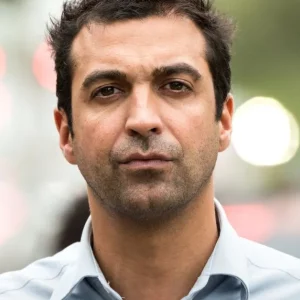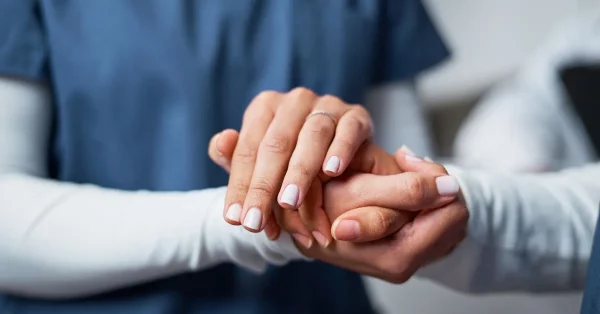Shoulder pain after stroke can stem from a variety causes, each responding to different treatments. Working with a physical or occupational therapist can be essential to learn effective techniques for managing shoulder pain after stroke.
This article will discuss the causes of shoulder pain after stroke and describe evidence-based treatments for relieving post-stroke shoulder pain. Feel free to use the links below to jump directly to any section of this article.
- Causes of shoulder pain after stroke
- Effects of a painful shoulder
- Rehabilitation methods
- Pain management techniques
Causes of Shoulder Pain After Stroke
According to the American Stroke Association, up to 84% of stroke survivors experience shoulder pain. This makes it one of the most common post-stroke effects. Individuals with hemiparesis (one-sided weakness), hemiplegia (one-sided paralysis), and shoulder subluxation (partial dislocation) are especially prone to developing shoulder pain after stroke.
There are many other factors that may contribute to shoulder pain after stroke, including:
- Improper positioning. Poor positioning of the shoulder when sitting, resting or standing can increase stress on the shoulder joint which, over time, may result in pain.
- Neglect and learned nonuse. Hemineglect is a condition referring to a lack of attention toward one side of the body/surroundings. This may lead to learned nonuse, which occurs when survivors simply stop using their affected arm. Both of these conditions increase the likelihood of experiencing limited shoulder mobility, injury, and pain.
- Spasticity. Muscle stiffness after stroke is often due to a condition called spasticity. When spasticity affects the muscles in the arm and shoulder, it may result in shoulder pain.
- Frozen shoulder. Prolonged shoulder immobilization or stress on the joint and ligaments of a partially dislocated shoulder may lead to a painful condition called frozen shoulder.
- Secondary complications. Other complications, like diabetes, limited arm function, post-stroke pain and neuropathy can be risk factors for shoulder pain after stroke. Sensory changes may also exacerbate shoulder pain in some survivors.
Medical imaging, strength and range of motion assessments, and special tests may be used to identify the factors contributing to shoulder pain after stroke. With so many different causes of shoulder pain, it is vital for survivors to work with their doctors and therapists for an accurate diagnosis.
Effects of Shoulder Pain after Stroke
Shoulder pain after stroke may affect many aspects of a survivor’s daily life. Since many individuals with shoulder pain after stroke also experience limited shoulder mobility, they may have difficulties completing their activities of daily living, such as dressing and moving throughout the home. Other daily tasks, such as meal preparation and work-related activities, may also become more challenging.
One study found that over half of survivors with shoulder pain had trouble with dressing and nearly one-third experienced difficulties walking at four months post-stroke. However, many survivors demonstrated functional improvements when they reached 16 months after their stroke, with only 31% consistently reporting trouble with dressing and 13% reporting shoulder pain affecting ambulation. Ambulation may be especially affected among survivors using assistive devices like canes or walkers.
Furthermore, many individuals with shoulder pain after stroke experience difficulties sleeping. This may be due to multiple factors, including waking due to pain or having difficulties finding a comfortable position. Studies have also linked depression and a reduced quality of life with shoulder pain after stroke.
Finding relief from shoulder pain after stroke may help survivors complete their daily activities with less difficulty and improve their overall wellness. There are two primary methods for relieving shoulder pain after stroke: rehabilitating the shoulder and utilizing pain management strategies.
Rehabilitation Methods for Relieving Shoulder Pain After Stroke
Addressing the root cause of shoulder pain after stroke through rehabilitation can help survivors alleviate pain and regain shoulder function. Practicing rehabilitative exercises and activities consistently can spark neuroplasticity, or the brain’s ability to adaptively rewire itself.
Both physical and occupational therapists can provide individualized recommendations regarding which rehabilitative methods may be best to promote neuroplasticity and recovery. The following list includes commonly used post-stroke rehabilitation methods for shoulder pain:
Range of Motion Exercises
Range of motion exercises are therapeutic and can alleviate shoulder pain over time. Typically, gentle passive range of motion exercises are recommended initially before progressing to more active exercises. Practicing range of motion exercises can help with decreasing spasticity and improving mobility along with relieving pain.
Great caution should be taken with any arm or shoulder exercises performed independently at home without the guidance of a therapist. This is because performing shoulder movements improperly can increase pain and lead to further injury.
Want 25 pages of stroke recovery exercises in a PDF? Click here to download our free Stroke Rehab Exercise ebook now (link opens a pop up for uninterrupted reading)
Electrical Stimulation
Electrical stimulation is a therapeutic technique that involves applying electrical stimulation through electrodes on the skin. Types of electrical stimulation include transcutaneous electrical nerve stimulation (TENS) and neuromuscular electrical stimulation (NMES).
While these therapies should be used in conjunction with other treatments, they do have the ability to reduce the pain signals, improve movement, and promote adaptive brain rewiring. Although much of the evidence is positive, more research is needed to strongly demonstrate the effectiveness of electrical stimulation for reducing shoulder pain after stroke.
Mental Practice
Mental practice, a technique involving visualizing oneself performing shoulder exercises in a pain-free manner, offers a safe and effective way to decrease shoulder pain after stroke. Mirror therapy can also be used to enhance mental practice. Due to the placement of a mirror at the body’s midline, mirror therapy provides the visual illusion that the affected arm is able to move effectively, while survivors are actually seeing a reflection of the unaffected arm moving.
Studies have shown that mental practice and mirror therapy can activate neuroplasticity in a similar fashion as actual practice. Furthermore, combining both mental practice and physical training has been shown to improve arm function more than physical training alone.
There are always new rehabilitative techniques being researched to relieve shoulder pain after stroke, including robotic-assisted therapy and virtual reality interventions. Therefore, even if conventional rehabilitative methods for reducing shoulder pain have been ineffective, there may be hope for pain relief and functional improvements in the future.
Management Techniques for Shoulder Pain After Stroke
During stroke rehabilitation, it’s ideal to treat the central problem as opposed to only addressing the secondary effects. For example, in the case of those with shoulder pain after stroke, survivors should strive to address the underlying cause of shoulder pain and promote adaptive brain rewiring, rather than simply finding a way to make the pain go away.
However, while participating in post-stroke rehabilitation, doctors and therapists may use specialized pain management techniques to alleviate shoulder pain. Here are some effective techniques to manage shoulder pain after stroke:
Therapeutic Taping
When shoulder pain is caused by poor positioning of the shoulder, therapeutic taping can temporarily improve this to relieve pain. Taping can be effective for preventing shoulder pain as well. Although the tape needs to be reapplied every few days, therapists can train survivors or their family members to apply tape at home as needed.
Shoulder Braces for Subluxation
Shoulder subluxation is especially common among survivors with hemiplegia due to the combination of shoulder weakness and gravity’s pull on the arm. These factors together cause the arm to separate from the joint, resulting in the painful condition of shoulder subluxation.
A shoulder brace or orthosis may be recommended to help survivors place the arm in a supported position, lessening subluxation and reducing pain. It is essential to discuss which brace may be most beneficial and what an appropriate brace wearing schedule would look like with a doctor or therapist for optimal results.
Positioning Techniques
Positioning techniques are effective for survivors with limited movement and strength in the affected arm. These individuals often have an increased risk of contractures, shoulder subluxation, and pain, which can be managed through appropriate postures and positioning techniques.
A physical or occupational therapist can demonstrate how to correctly position the arm to avoid these negative outcomes. They may also recommend using wheelchair arm supports, pillows or certain slings for arm support at home.
Hands-On Therapies
Hands-on techniques, such as massage therapy and acupuncture, may also be used to help relieve shoulder pain after stroke. Therapeutic massage can help relieve muscle tension and spasticity, thereby relieving shoulder pain. Acupuncture and electroacupuncture have also been shown to alleviate shoulder pain through stimulating specific acupoints.
Medications and Injections
Some medications may assist with pain relief after stroke. These may include analgesics (pain relievers), anti-inflammatory medication, or antispastic drugs. The most effective medication depends on the cause of the survivor’s shoulder pain, so it is important to discuss pharmaceutical pain relief with one’s doctor.
Nerve blocks or injections may also be recommended to reduce shoulder pain after stroke. For example, corticosteroid injections can help relieve pain through their anti-inflammatory effects, while Botox can help temporarily reduce spasticity and thereby pain after stroke. Some survivors use this relief as a “window of opportunity” to focus on their rehabilitation goals while their pain is diminished.
Surgery
If none of the rehabilitation and compensation techniques mentioned above provide relief, doctors may recommend surgery to help alleviate shoulder pain. This is relatively uncommon, and typically used as a last resort.
Relieving Shoulder Pain After Stroke
Shoulder pain after stroke has a variety of causes. Often, it is the result of improper positioning, shoulder subluxation, or weakness. Shoulder pain after stroke can result in difficulties with daily activities and trouble sleeping, reducing the survivor’s quality of life.
Therapeutic methods, like physical therapy exercises and mental practice, can help improve mobility to relieve pain long-term. Other techniques, like medications and orthotics, may provide faster short-term relief. It is often most effective to use a combination of rehabilitative methods and management techniques to reduce shoulder pain after stroke, enhance functional abilities, and improve quality of life.









